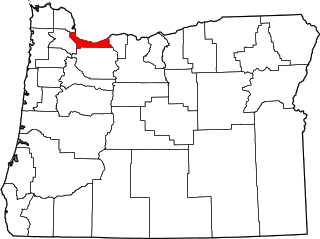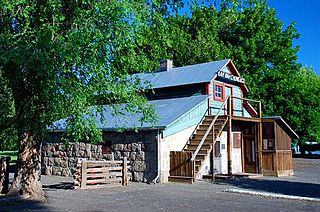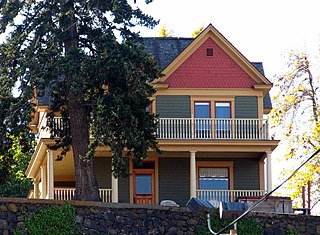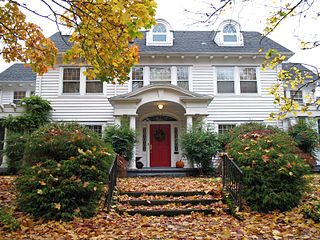
The following list presents the full set of National Register of Historic Places listings in Multnomah County, Oregon. However, please see separate articles for listings in each of Portland's six quadrants.

Fort Dalles was a United States Army outpost located on the Columbia River at the present location of The Dalles, Oregon, in the United States. Built when Oregon was a territory, the post was used mainly for dealing with wars with Native Americans. The post was first known as Camp Drum and then Fort Drum.

The Kam Wah Chung & Co. Museum, also known as Kam Wah Chung Company Building, is a state park and a National Historic Landmark that preserves early Chinese culture in John Day in the U.S. state of Oregon. Built in the 1865 by George Hazeltine as a supply depot or stagecoach stop along the Dalles-Canyon City wagon road., it is the best-preserved example of a Chinese herbal apothecary and mercantile establishment dating to the post-Civil War period of growth in the Western United States.

The Edward F. Sharp Residential Ensemble, also known as the Sharp Family Residential Ensemble, is a set of three adjacent historic houses in The Dalles, Oregon, United States. Edward Sharp (1865–1954) was the county surveyor and roadmaster whose work underlies much of the development in The Dalles and Wasco County. As the official surveyor for the Eastern Oregon Land Company, he also conducted important early surveys across large stretches of Oregon and Idaho. He built the houses at 400 and 404 E. 4th Street for himself and his family, and the house at 504 Federal Street for employees (1900). Because the houses remained under common ownership in the Sharp family for many years, they have retained an exceptional level of preservation. The houses on 4th Street are also exceptional local examples of the Queen Anne (400) and Craftsman (404) styles.

Trevitt's Addition Historic District is a neighborhood, primarily residential in character, located in The Dalles, Oregon, United States. Victor Trevitt platted the first expansion of the original 1855 "Dalles City" townsite in 1860, and continued to extend his addition in response to economic developments. The district saw the first flour mill and electrical and water systems in The Dalles, one of the area's earliest Catholic churches, and direct connection to transportation networks including the Columbia River Highway and the railroad. Surviving buildings in the district reflect a continuous spectrum of architectural styles from 1864 to 1937.

The Bennett–Williams House is a historic house, located in The Dalles, Oregon, United States. It is listed on the National Register of Historic Places, and is also listed as a contributing resource in the National Register-listed Trevitt's Addition Historic District.

The Fulton–Taylor House is a historic house located in The Dalles, Oregon, United States. Built and modified in phases between circa 1858 and circa 1930, this house is only one of a few remaining houses of similar age and style in The Dalles. James Fulton emigrated to Oregon on the Oregon Trail, and eventually established himself as a cattle rancher, leader of the settler militia, and a state legislator. The Rev. O.D. Taylor was a Baptist minister, but was far more noted as the driving force behind a major, failed, but long-running real estate scheme that was widely regarded as fraudulent.

The Heimrich–Seufert House is a historic house in The Dalles, Oregon, United States.

The Lewis Anderson House, Barn and Granary is a historic ensemble of buildings, currently located in The Dalles, Oregon, United States. This well-preserved set of 1890s Swedish American vernacular architecture was originally located on a farm on Pleasant Ridge, south of The Dalles. Lewis Anderson was a Swedish immigrant who, after establishing himself on Pleasant Ridge, worked semi-successfully to encourage further Swedish settlement in the area of The Dalles. The sidehill barn, with grade entrances on two levels, was the first erected of the ensemble, in 1890. The house was built by Anderson and fellow Swedish immigrant Ab Pearson in 1895. Anderson purchased and relocated the granary from a neighboring farm in 1898, in the process repurposing it from its previous function as a house.

The Hugh Glenn House is a historic house located in The Dalles, Oregon, United States. It is one of the most notable and historically well-preserved Queen Anne-style houses in The Dalles. Hugh Glenn, a prominent architect and businessman in The Dalles, designed and built the house around 1882 and lived there until his death in 1927.

The Orlando Humason House is a historic house located in The Dalles, Oregon, United States. Humason (1828–1875), the "Father of Wasco County", lived in this modest Gothic Revival house from its construction in 1860 until his death. Originally from Ohio, he worked in law, prospecting, agriculture, and journalism, prior to settling in The Dalles as a prosperous merchant and river transport businessman. Representing first Oregon City then The Dalles in the territorial and state legislatures, he introduced legislation establishing Wasco County, Multnomah County, and the City of The Dalles. He also championed a bill to build a canal around the Cascades Rapids to allow Lower Columbia shipping to reach The Dalles, which did not come to fruition in his lifetime. Humason's other public positions included mayor of The Dalles and Wasco County judge. The house is architecturally notable as one of very few Gothic Revival houses in The Dalles.

The former United States Post Office in The Dalles, Oregon, United States, is a historic building constructed in 1916. Executed from standardized federal plans in the Greek Revival style, it was the first federal building in The Dalles and one of a set of nine built in Oregon in the 1910s. It remained in operation as a post office longer than seven of the other eight in that group. The building was added to the National Register of Historic Places in 1985.

The Dalles Mint was to be a branch of the United States Mint in The Dalles in Oregon. Partially constructed in 1869, the planned two-story structure was never completed and the mint was never put into operation. Located in the downtown area of the city, the building was given to the state before it was sold to the public. The Mint building was most recently home to the Erin Glenn Winery.

The Joseph D. and Margaret Kelly House is a historic residence in The Dalles, Oregon, United States. Joseph Kelly, a highly successful farmer during the establishment of wheat as a major cash crop in Wasco County, retired young to this 1908 blufftop house and continued his career as a landlord and businessman. He and his wife Margaret, a teacher and member of another important wheat family, became a prominent philanthropic figures in The Dalles. The house is architecturally notable for its vernacular rendering of the Queen Anne style, reflecting the Kellys' rural background in contrast to the high Victorian approach used elsewhere in The Dalles.

The John L. Thompson House is a historic house in The Dalles, Oregon, United States. John L. Thompson, an American emigrant and successful blacksmith, built his house in 1889 in a simple, one-story vernacular style. Subsequently, in 1897, the house underwent a significant expansion to become a prominent Queen Anne residence. The house represents the evolution of architecture in frontier towns, and is one of The Dalles' outstanding examples of the Queen Anne style. It was converted to professional offices in 1979.

The Dr. J. A. Reuter House is a historic house in The Dalles, Oregon, United States. John Alexander Reuter (1876–1954) practiced medicine in The Dalles for 44 years (1902–1946), joining a partnership that established the city's first hospital (1901) and nursing school, as well as a large private clinic (1937). He bought this house in 1909 and radically transformed it by jacking the old house up to become the second floor and building a new first floor beneath. He also completely remodeled it to become the city's finest example of the Craftsman style.

The Fivemile Rapids Site, is an archaeological site near The Dalles, Oregon, United States. Yielding remains beginning soon after the end of the last glacial period, this and other nearby sites provide a nearly continuous record of human occupation from at least 9000 BCE to 1820 CE. It also provides some of the earliest available evidence of fishing in human economy.

The Seufert House, also known as the Mautz–Seufert House, is a historic residence in Portland, Oregon, United States. From 1914 to 1929, it was the Portland home of fishing and canning businessman Francis A. Seufert (1853–1929), who was an innovative leader in the upper Columbia River salmon industry at The Dalles. He pioneered use of the fish wheel to harvest fish, as well as the shipment of fresh, iced salmon to eastern markets. The house, built in 1913 in the Colonial Revival style, was the product of the Mautz Building and Investment Company, which built over fifty homes in the exclusive Irvington neighborhood. It was briefly occupied by Edmund J. Mautz prior to its sale to Francis Seufert.





















